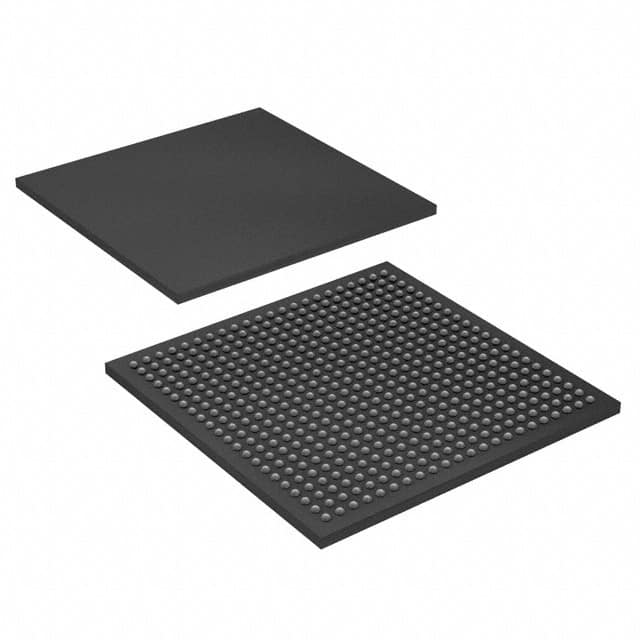10CL055YF484C6G
Product Overview
Category
10CL055YF484C6G belongs to the category of Field-Programmable Gate Arrays (FPGAs).
Use
FPGAs are integrated circuits that can be programmed or reprogrammed after manufacturing. They are widely used in various electronic applications, including telecommunications, automotive, aerospace, and consumer electronics.
Characteristics
- High flexibility: FPGAs can be customized to perform specific functions by programming the logic gates and interconnections.
- Parallel processing: FPGAs can execute multiple tasks simultaneously, making them suitable for high-performance computing.
- Reconfigurability: FPGAs can be reprogrammed to adapt to changing requirements or to fix errors without replacing the hardware.
- Low power consumption: FPGAs offer efficient power management features, making them energy-efficient compared to other programmable devices.
Package and Quantity
The 10CL055YF484C6G FPGA is available in a 484-ball FineLine BGA package. The quantity per package may vary depending on the supplier.
Specifications
- Logic Elements: 55,000
- Embedded Memory: 2,856 Kbits
- DSP Blocks: 360
- Maximum User I/Os: 266
- Operating Voltage: 1.2V
- Speed Grade: -6
Pin Configuration
The detailed pin configuration of 10CL055YF484C6G can be found in the manufacturer's datasheet.
Functional Features
- High-speed data processing: The FPGA offers fast data processing capabilities, enabling real-time applications.
- Configurable I/O standards: It supports various input/output voltage standards, allowing compatibility with different interfaces.
- On-chip memory: The embedded memory blocks provide additional storage for data processing.
- Clock management: The FPGA includes clock management resources for precise timing control.
- Built-in DSP blocks: The integrated digital signal processing blocks enable efficient implementation of complex algorithms.
Advantages
- Flexibility: FPGAs can be customized to meet specific application requirements, providing a high degree of flexibility.
- Time-to-market: FPGAs allow for rapid prototyping and development cycles, reducing time-to-market for new products.
- Cost-effective: FPGAs eliminate the need for custom ASICs, reducing development costs for low to medium volume applications.
- Reconfigurability: FPGAs can adapt to changing standards or functionalities without requiring hardware changes.
Disadvantages
- Power consumption: FPGAs can consume more power compared to dedicated hardware solutions.
- Complexity: Designing and programming FPGAs require specialized knowledge and expertise.
- Limited performance for certain applications: FPGAs may not offer the same level of performance as dedicated application-specific integrated circuits (ASICs) for highly specialized tasks.
Working Principles
FPGAs consist of an array of configurable logic blocks interconnected through programmable routing resources. The logic blocks can be programmed to implement desired functions using a hardware description language (HDL). During operation, the FPGA executes the programmed logic to perform the desired tasks.
Application Field Plans
The 10CL055YF484C6G FPGA can be used in various applications, including: - Wireless communication systems - Video and image processing - Industrial automation - Automotive electronics - Medical devices
Alternative Models
- 10CL025YF484C6G: A lower-capacity version with 25,000 logic elements.
- 10CL085YF484C6G: A higher-capacity version with 85,000 logic elements.
- 10CL010YF484C6G: A lower-cost version with 10,000 logic elements.
These alternative models provide different capacity options to suit specific application requirements.
In conclusion, the 10CL055YF484C6G FPGA is a versatile and flexible device that offers high-performance data processing capabilities. Its reconfigurability and wide range of applications make it a popular choice in various industries.
10個與10CL055YF484C6G在技術方案中應用相關的常見問題與解答
Sure! Here are 10 common questions and answers related to the application of 10CL055YF484C6G in technical solutions:
Q: What is 10CL055YF484C6G? A: 10CL055YF484C6G is a specific model number for a field-programmable gate array (FPGA) manufactured by Intel.
Q: What are the key features of 10CL055YF484C6G? A: Some key features of 10CL055YF484C6G include 55,000 logic elements, 484-pin package, and support for various I/O standards.
Q: In what applications can 10CL055YF484C6G be used? A: 10CL055YF484C6G can be used in a wide range of applications such as telecommunications, industrial automation, automotive, and aerospace.
Q: How can 10CL055YF484C6G enhance technical solutions? A: 10CL055YF484C6G can enhance technical solutions by providing programmable logic that allows for customization, flexibility, and high-performance computing capabilities.
Q: What programming languages are supported by 10CL055YF484C6G? A: 10CL055YF484C6G supports popular hardware description languages (HDLs) such as VHDL and Verilog.
Q: Can 10CL055YF484C6G interface with other components or devices? A: Yes, 10CL055YF484C6G can interface with other components or devices through its I/O pins, which support various communication protocols.
Q: Is there any development tool available for programming 10CL055YF484C6G? A: Yes, Intel provides development tools like Quartus Prime software suite that allows users to program and configure 10CL055YF484C6G.
Q: What is the power consumption of 10CL055YF484C6G? A: The power consumption of 10CL055YF484C6G depends on the specific design and usage scenario. It is recommended to refer to the datasheet for detailed power specifications.
Q: Can 10CL055YF484C6G be used in safety-critical applications? A: Yes, 10CL055YF484C6G can be used in safety-critical applications with proper design considerations and adherence to relevant safety standards.
Q: Where can I find more information about 10CL055YF484C6G? A: You can find more information about 10CL055YF484C6G on Intel's official website or by referring to the product datasheet and application notes provided by the manufacturer.
Please note that the answers provided here are general and may vary depending on the specific requirements and use cases.


